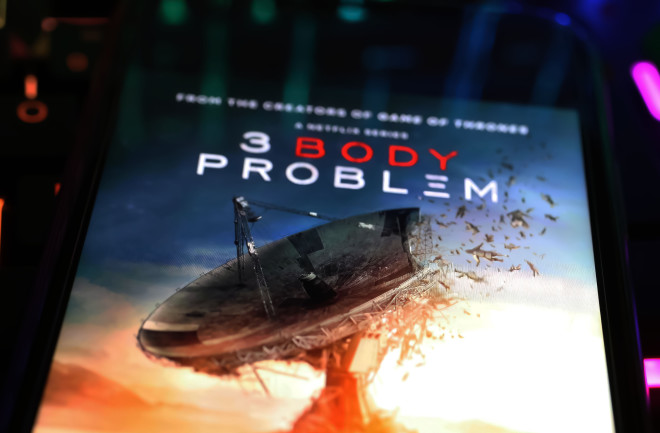Netflix's 3 Body Problem has been generating a lot of buzz since its premiere last month, and it's not hard to see why: The hit new series is being helmed by Game of Thrones showrunners David Benioff and D.B. Weiss, along with screenwriter Alexander Woo, and adapts a bestselling sci-fi book trilogy by Chinese writer Liu Cixin.
Both series explore thorny theoretical ideas posed by quantum mechanics, and don't skimp on the science, either. In fact, the series namesake — the titular three-body problem — involves an unsolvable physics conundrum that has baffled scientists for centuries.
Paul Sutter, a theoretical cosmologist, award-winning science communicator, NASA advisor, and U.S. Cultural Ambassador helps break down the real-world science behind the fiction.
What Is the Real Three-Body Problem?
The three-body problem is the original, and perhaps greatest, unsolved problem in all of physics. And while we know that we will likely never find a true solution to it, its existence continues to propel even the most advanced of our theories.
Read More: Our Moral Obligations for Parallel Universes are Unclear, Says Expert Paul Sutter
The trouble began all the way back in the early 1700’s. Sir Isaac Newton had just revolutionized our understanding of the physical world by realizing that gravity was a universal force: It causes the motion of everything from an apple falling from a tree to the orbit of the Moon around the Earth. It was also a major advance in mathematical physics. With a simple equation, now you could do the seemingly impossible: predict the future.
For example, if you know the masses of two objects in space and their distance from each other, then you can use Newton’s law of gravitation to predict exactly how those objects will move throughout the rest of time. And as an added bonus, all you need is a pencil and plenty of paper to get the job done.
Naturally, given Newton’s insight, physicists wanted to apply his technique to all sorts of scenarios. For example, Sir Edmund Halley was famously able to predict the reappearance of his eponymous comet and the timing of a total solar eclipse in 1715. But the real solar system is often much more complex than just two individual objects interacting with each other.
The next step up in difficulty is to solve for the gravitational movement of three objects, and that quickly proved to be, well, impossible. Try as they might, nobody could write down a simple formula that predicted with absolute certainty how three objects would behave when interacting with gravity: this is the root of the three-body problem.
Efforts to Solve the Three-Body Problem
Through the centuries many famous mathematicians and physicists, like Leonhard Euler, Joseph-Louis Lagrange, and Henri Poincare, have thrown themselves at the problem, to varying levels of success.
For example, Euler found that if all three objects start off in a straight line you can find some solutions to their future motions. Lagrange discovered that if one of the objects is much, much smaller than the other two, you can find some points of stability where the third object will maintain in equilibrium (which are now known as Lagrange points in his honor).
Read More: Have the Laws of Physics Ever Been Broken?
It even rose to the level of a competition. In 1889 Oscar II, King of Sweden and Norway, announced an international prize for anyone who could solve the three-body problem. Poincare responded to the challenge and ended up writing an entire book dedicated to the subject.
Even though he was awarded the prize, he didn’t think he deserved it – after all, even after writing the book, he still hadn’t solved the problem for all cases, only finding to his dismay a rich series of limited solutions and special cases.
The Rise of Chaos Theory
These giants of mathematics didn’t realize that they were dealing with a whole new kind of physics, one that we didn’t recognize until the mid-twentieth century. The three-body problem is our earliest known example of what we now call chaos theory. Chaos theory refers to a special set of problems that, although they can appear extremely simple, are outright impossible to solve.
The real issue behind chaos theory is something known as sensitivity to initial conditions. If you change one tiny little thing about the starting point of your planets, for example, you’ll end up in a completely different set of orbits than what you predicted.
Read More: 5 Obscure Formulas That Rule the World
Since it’s impossible to measure with infinite precision the position of any planet, this sensitivity means that we are fundamentally limited in how far into the future we can predict the motions of objects in the three-body problem.
Chaos theory now sits as its own branch of physics, informing such seemingly unrelated phenomena as weather systems and population dynamics.
New Interest in the Three-Body Problem
Pop culture aside, in recent years, the three-body problem has taken on renewed interest in astronomy over the question of planetary habitability and extraterrestrial life. Most of the stars in the Milky Way galaxy are binary pairs, or more, and for years, astronomers assumed that planets could not exist around those stars in a stable orbit.
Read More: 10 Facts You May Not Know About the Milky Way
But astronomers have indeed discovered exoplanets orbiting binary stars, in all sorts of strange orbits. Determining if these planets can host life requires an understanding of the long-term stability of their orbits — which means solving the three-body problem once and for all.
Paul M. Sutter is a theoretical cosmologist, NASA advisor, host of the "Ask a Spaceman" podcast, and a U.S. Cultural Ambassador. He is the author of Your Place in the Universe and How to Die in Space.

